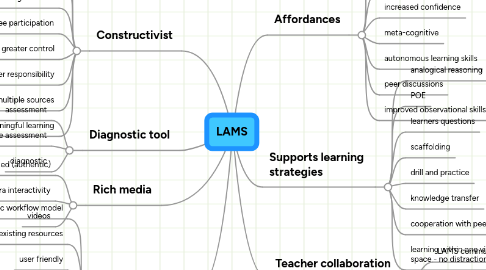LAMS
作者:Amanda Mendham

1. Constructivist
1.1. context vs content
1.2. activity vs absorption
1.3. multi vs single learner
1.4. 'risk free participation
1.5. greater control
1.6. greater responsibility
1.7. multiple sources
1.8. authentic & meaningful learning
2. Diagnostic tool
2.1. assessment
2.2. summative assessment
2.3. diagnostic
3. Rich media
3.1. web-based (authentic)
3.2. extra interactivity
3.3. videos
4. Easy authoring
4.1. graphic workflow model
4.2. editing of existing resources
4.3. user friendly
4.4. re-useable
4.5. freely available software
4.6. teacher's control over students' progress
5. Affordances
5.1. student motivation
5.2. non-threatening contribution
5.3. self-pacing
5.4. increased confidence
5.5. meta-cognitive
5.6. autonomous learning skills
5.7. peer discussions
5.8. improved observational skills
6. Supports learning strategies
6.1. analogical reasoning
6.2. POE
6.3. learners questions
6.4. scaffolding
6.5. drill and practice
6.6. knowledge transfer
6.7. cooperation with peers
6.8. learning within one virtual space - no distraction
7. Teacher collaboration
7.1. LAMS community
7.2. activities adapted across-discipline


